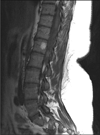Correlation of MRI-Based bone marrow burden score with genotype and spleen status in Gaucher's disease
- PMID: 18562733
- PMCID: PMC3731993
- DOI: 10.2214/AJR.07.3550
Correlation of MRI-Based bone marrow burden score with genotype and spleen status in Gaucher's disease
Abstract
Objective: The purpose of this study was to correlate skeletal pathologic findings quantified by MRI-based bone marrow burden score with genotype and spleen status and other clinical parameters, including liver size and duration of enzyme replacement therapy, in patients with Gaucher's disease.
Materials and methods: Two radiologists retrospectively reviewed MR images of 47 patients with Gaucher's disease and determined bone marrow burden scores by consensus on the basis of previously published criteria. The bone marrow burden scores were correlated with genotype, liver volume, spleen status, age, and cumulative duration of enzyme replacement therapy.
Results: Subjects with compound heterozygous N370S alleles had significantly higher overall, lumbar spinal, and femoral bone marrow burden scores than did N370S homozygotes. There was a significant positive correlation between an enlarged or surgically absent spleen and bone marrow burden score. There were no significant associations between bone marrow burden score and liver volume, age, cumulative duration of enzyme replacement therapy, or cumulative duration of untreated disease. Femoral and lumbar spinal bone marrow burden scores had a weak but significant positive correlation across all patients.
Conclusion: Skeletal pathologic findings in Gaucher's disease encapsulated as bone marrow burden score correlate significantly with the number of copies of the N370S allele, which has an ameliorative effect on bone marrow disease. Splenectomy or splenomegaly is associated with greater risk of bone marrow disease. Femoral and lumbar spinal bone marrow burden scores, although only weakly correlated, independently illustrated both the protective role of the N370S allele and the unfavourable implication of splenectomy. This finding suggests that axial and appendicular bone marrow burdens are related but distinct and justifies multiple-compartment evaluation in Gaucher's disease.
Figures










Similar articles
-
Semiquantitative assessment of skeletal response to enzyme replacement therapy for Gaucher's disease using the bone marrow burden score.AJR Am J Roentgenol. 2007 Jun;188(6):1521-8. doi: 10.2214/AJR.06.1410. AJR Am J Roentgenol. 2007. PMID: 17515371 Clinical Trial.
-
Severity of bone marrow involvement in patients with Gaucher's disease evaluated by scintigraphy with 99mTc-sestamibi.J Nucl Med. 2003 Aug;44(8):1253-62. J Nucl Med. 2003. PMID: 12902415 Clinical Trial.
-
Report of the Spanish Gaucher's disease registry: clinical and genetic characteristics.Haematologica. 2000 Aug;85(8):792-9. Haematologica. 2000. PMID: 10942924
-
Gaucher's disease: molecular, genetic and enzymological aspects.Baillieres Clin Haematol. 1997 Dec;10(4):635-56. doi: 10.1016/s0950-3536(97)80032-7. Baillieres Clin Haematol. 1997. PMID: 9497856 Review.
-
[Gaucher's disease: current aspects].Rev Med Interne. 1995;16(6):447-56. doi: 10.1016/0248-8663(96)80738-7. Rev Med Interne. 1995. PMID: 7652229 Review. French.
Cited by
-
Skeletal Manifestations, Bone Pain, and BMD Changes in Albanian Type 1 Gaucher Patients Treated with Taliglucerase Alfa.J Osteoporos. 2023 Dec 4;2023:3254533. doi: 10.1155/2023/3254533. eCollection 2023. J Osteoporos. 2023. PMID: 38090017 Free PMC article.
-
Imaging of non-neuronopathic Gaucher disease: recent advances in quantitative imaging and comprehensive assessment of disease involvement.Insights Imaging. 2019 Jul 10;10(1):70. doi: 10.1186/s13244-019-0743-5. Insights Imaging. 2019. PMID: 31289964 Free PMC article. Review.
-
Gaucher Disease in Bone: From Pathophysiology to Practice.J Bone Miner Res. 2019 Jun;34(6):996-1013. doi: 10.1002/jbmr.3734. Epub 2019 Jun 24. J Bone Miner Res. 2019. PMID: 31233632 Free PMC article. Review.
-
Skeletal involvement in Gaucher disease: extent of bone disease, splenic volume, and quality of life.Radiol Bras. 2021 Mar-Apr;54(2):71-76. doi: 10.1590/0100-3984.2020.0014. Radiol Bras. 2021. PMID: 33854259 Free PMC article.
-
Radiological aspects of Gaucher disease.Skeletal Radiol. 2011 Dec;40(12):1505-13. doi: 10.1007/s00256-010-0992-3. Epub 2010 Jul 25. Skeletal Radiol. 2011. PMID: 20658285 Review.
References
-
- Hermann G, Pastores GM, Abdelwahab IF, Lorberboym AM. Gaucher disease: assessment of skeletal involvement and therapeutic responses to enzyme replacement. Skeletal Radiol. 1997;26:687–696. - PubMed
-
- Wenstrup RJ, Roca-Espiau M, Weinreb NJ, Bembi B. Skeletal aspects of Gaucher disease: a review. Br J Radiol. 2002;75(suppl 1):A2–A12. - PubMed
-
- Stowens DW, Teitelbaum SL, Kahn AJ, Barranger JA. Skeletal complications of Gaucher disease. Medicine. 1985;64:310–322. - PubMed
-
- Charrow I, Esplin JA, Gribble TJ, et al. Gaucher disease: recommendations on diagnosis, evaluation, and monitoring. Arch Intern Med. 1998;158:1754–1760. - PubMed
-
- Mankin HJ, Rosenthal DI, Xavier R. Gaucher disease: new approaches to an ancient disease. J Bone Joint Surg Am. 2001;83:748–763. - PubMed
MeSH terms
Grants and funding
LinkOut - more resources
Full Text Sources
Medical

